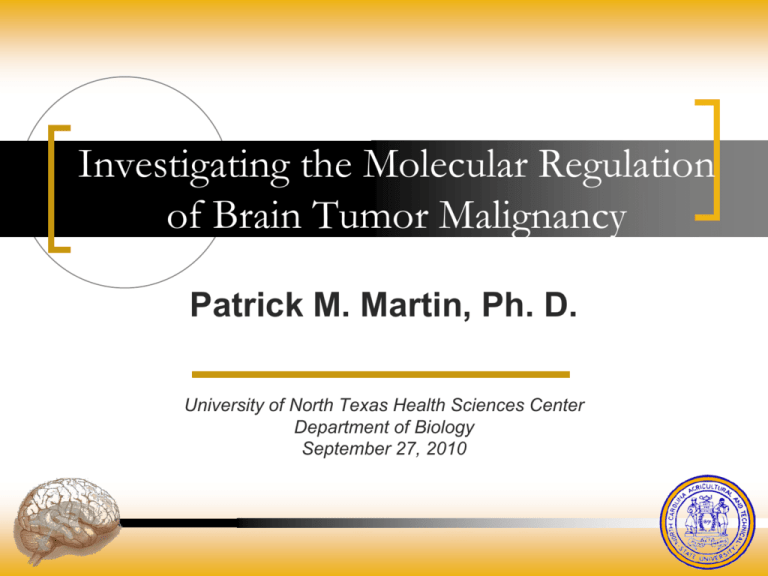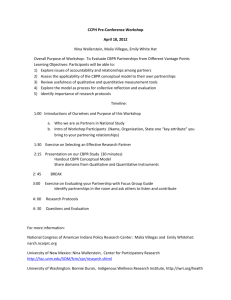fra-1 - University of North Texas Health Science Center
advertisement

Investigating the Molecular Regulation of Brain Tumor Malignancy Patrick M. Martin, Ph. D. University of North Texas Health Sciences Center Department of Biology September 27, 2010 Primary Tumors of the Brain Account for 2% of all primary tumors World Health Organization classifies brain tumors into four grades Grade I: Pilocytic astrocytoma Grade II: Diffuse astrocytoma Grade III: Anaplastic astrocytoma (Diffuse) Grade IV: Glioblastoma Multiforme adapted from: Reifenberger and Collins (2004) Glioblastoma Multiforme (GBM) The most lethal and malignant form of primary brain tumors found in adults Prognosis for Patients is quite poor Incidence rate of 3.1 per 100,000 persons/year in United States 2-year survival rate of 8% Median survival Rate of 13 months Chromosomal and genetic alterations associated with astrocytic gliomas Astrocyte or glial precursor cells EGFR amplification/overexpression P53 mutation (<30%) RB1 mutation/homozygous deletion LOH 10p and 10q CDK 4 and 6 PTEN mutation (30-40%) Primary GBM (WHO Grade IV) Adapted from Kleihus et al. (2000) Glioblastoma Growth Characteristics ● Rapid growth and diffuse infiltration into normal brain ● GBM is often resistant to radiotherapy and many chemotherapeutic agents are not effective ● Transcription Factors (Fra-1, C-Jun, C-Fos, etc.), Adhesion molecules (CD44, Integrins, etc.)are constitutively active or over-expressed in tumor samples and GBM cell lines More GBM Images MRI of GBM in 55 year old Female. British Journal of Radiology GBM at time of surgical resection American Journal of Neuroradiology GBM at autopsy (notice secondary tumor site),WebPath Notable Individuals Diagnosed with Brain Tumors Senator Edward “Ted” Kennedy Johnnie Cochran Glioblastoma Migration and Invasion Claes A et al. Acta Neuropathologica 2007;114(5):443-458 CD44: An Adhesion Molecule A transmembrane glycoprotein CD44 is a membrane glycoprotein that is the principal membrane receptor for hyaluronan (HA). HA is a major component of the extra cellular matrix (ECM) in the brain Role of CD44 in Gliomagenesis CD44 and HA expression is significantly increased during the formation and migration of GBMs (reviewed by Bellail et al., 2004) Expression in primary malignant gliomas is restricted to the white matter (Bellail et al., 2004) Brain Sections Role of Fra-1 Fos Related Antigen Transcription factor that is a member of the activator protein-1 (AP-1) family Early response proto-oncogene Response to growth factors and promote increased transcription of specific gene targets (Curran & Franza, 1988) Expression and activity are increased in high grade gliomas especially glioblastomas (Debinski & Gibo 2005) Real-time Q-PCR for quantitation of selected genes up-regulated in (A) asbestos-exposed RPM cells and (B) mesothelioma 23 after transfection with sifra-1 or sd. Ramos-Nino M E et al. Cancer Res 2003;63:3539-3545 Use of shRNA constructs to knock-down Fra-1 confirm Fra-1-dependent CD44 expression in MMs. A. Western blots of SV40- (MM1) and SV40+ (MM3) lines showing empty vector (EV) controls or RNAi shFra-1 constructs. B. Immunofluorescence image showing CD44 (red) levels MM cell lines. Ramos-Nino et al. Molecular Cancer 2007;6:81 Overarching Research Objective To investigate the regulation of CD44 expression in human glioma cells by the transcription factor Fra-1 Approach #1: Approach #2: To examine the expression levels of CD44 and Fra-1 in glioma cells To assay whether Fra-1 promotes CD44 expression in GBM cells Approach #3: To investigate whether CD44-mediated glioma cell adhesion is promoted by the expression of Fra-1 Overall Hypothetical Model Malignant Gliomas Cell Invasive Migration Research Aim 1 To examine the expression levels of CD44 and Fra-1 in glioma cells Hypothesis: CD44 expression levels will correlate with the levels of Fra-1 expression in each cell line Experimental Design: Stimulation of GBM cells with Growth Factor ■ Epidermal Growth Factor (EGF) ■ Hepatocyte Growth Factor (HGF) Western Blot Analysis Immunofluorescence Hypothetical Model Growth Factor Fra-1 Fra-1 Fra-1 Fra-1 Fra-1 Preliminary Study of the Cell Lines EGF & HGF Stimulation of U-251 MG U-251 MG EGF (20 ng/ml) HGF (50 ng/ml) CD-44 80 kDa Rel. Abs. 1.0 0.9 1.0 1.0 1.6 1.0 Fra-1 45 kDa Rel. Abs. 1.0 1.3 0.9 1.0 1.8 1.1 β - Tubulin EGF & HGF Stimulation of U-1242 MG U-1242 MG EGF (20 ng/ml) HGF (50 ng/ml) CD-44 80 kDa Rel. Abs. 1.0 1.1 1.4 1.0 1.0 1.0 Fra-1 45 kDa Rel. Abs. 1.0 1.6 3.7 1.0 2.2 1.4 β - Tubulin Localization of CD44 and Fra-1 in Human GBM Cell lines EGF Stimulation of U-251 MG HGF Stimulation of U-251 MG EGF Stimulation of U-1242 MG HGF Stimulation of U-1242 MG Preliminary Conclusions # 1 U-251 MG U-1242 MG EGF does not increase CD44 expression HGF stimulation does increase CD44 expression EGF stimulation does increase CD44 expression HGF stimulation does not increase CD44 expression HGF increases Fra-1 expression more dramatically then EGF stimulation HGF – 4 hour stimulation EGF – 24 hour stimulation Research Aim 2 To determine whether the expression of CD44 is regulated by Fra-1 expression in glioma cells Hypothesis: Silencing the expression of Fra-1 will decrease the expression of CD44 Experimental Design: RNA Interference via Nucleofection Western Blot Analysis Immunofluorescence Hypothetical Model Growth Factor Fra-1 siRNA Fra-1 Fra-1 Fra-1 Fra-1 Fra-1 fra-1-siRNA treated Human GBM cells EGF stimulation of fra-1-siRNA treated U-251 GBM cells U-251 MG EGF (20 ng/ml) CD-44 80 kDa Rel. Abs. 1.0 0.9 1.0 1.0 0.9 0.7 Fra-1 45 kDa Rel. Abs. 1.0 1.1 1.4 0.9 1.1 0.9 β - Tubulin HGF stimulation of fra-1-siRNA treated U-251 GBM cells U-251 MG HGF (50 ng/ml) CD-44 80 kDa Rel. Abs. 1.0 1.7 1.9 2.3 1.9 2.1 Fra-1 45 kDa Rel. Abs. 1.0 1.3 1.4 1.4 1.2 1.4 β - Tubulin EGF stimulation of fra-1-siRNA treated U-1242 GBM cells U-1242 MG EGF (20 ng/ml) CD-44 80 kDa Rel. Abs. 1.0 1.1 1.4 1.3 1.1 1.0 Fra-1 45 kDa Rel. Abs. 1.0 1.6 1.7 1.4 1.3 1.1 β - Tubulin HGF stimulation of fra-1-siRNA treated U-1242 GBM cells U-1242 MG HGF (50 ng/ml) CD-44 80 kDa Rel. Abs. 1.0 0.8 1.2 0.5 0.8 1.1 Fra-1 45 kDa Rel. Abs. 1.0 1.7 1.8 0.6 1.3 1.5 β - Tubulin Localization of CD44 and Fra-1 of fra-1-siRNA treated U-1242 MG cells EGF stimulation of fra-1-siRNA treated U-1242 GBM cells 24 hr Control siRNA Fra-1 siRNA HGF stimulation of fra-1-siRNA treated U-1242 GBM cells 24 hr Control siRNA Fra-1 siRNA Preliminary Conclusions #2 EGF stimulation after fra-1-siRNA decreases CD44 and Fra-1 expression HGF stimulation after fra-1-siRNA has no affect on CD44 and Fra-1 expression HGF demonstrates a greater regulatory role on Fra-1 expression than EGF Research Aim 3 To investigate whether CD44-mediated glioma cell adhesion is promoted by the expression of Fra-1 Hypothesis: Glioma cell adhesion is promoted by the activation of Fra-1 through the regulation of CD44 expression Experimental Design: RNA Interference Cell Adhesion Assay Methods: Adhesion Assay Adhesion Assay of Human GBM Cell lines Adhesion Assay of EGF and HGF stimulated U-251 MG Cell Adhesion Assay of EGF and HGF stimulated U-1242 MG Cell Adhesion Assay of siRNA treated Human GBM Cell lines Adhesion Assay of siRNA treated EGF stimulated U-251 MG Cell Adhesion Assay of siRNA treated HGF stimulated U-251 MG Cell Adhesion Assay of siRNA treated EGF stimulated U-1242 MG Cell Adhesion Assay of siRNA treated HGF stimulated U-1242 MG Cell Preliminary Conclusions #3 Cell lines demonstrated an increase adherence to HA after growth factor stimulation U-251 MG – 4 hour stimulation U-1242 MG – 24 hour stimulation Data is comparable to the western blot analysis of the GBM cells CD44 binding to HA is cell line specific CD44-mediated HA binding of GBM cells can be regulated by Fra-1 expression Overall Summary Confirmed CD44 and Fra-1 expression in GBM Cell lines (U-1242 MG and U-251 MG) The regulation of CD44 is linked to Fra-1 expression and/or activity CD44-mediated HA binding of GBM cells is regulated by Fra-1 expression EGF and HGF demonstrate a differential regulatory effect on Fra-1 and CD44 expression in U-251 MG and U-1242 MG cell lines Final Model WHY? Theory of HGF regulation of Fra-1 Explanation # 1: Protective resistance against the fra-1 siRNA Explanation # 2: Fra-1 can autoregulate the transcription of its own transcript Theory of HGF regulation of Fra-1 HGF increases Fra-1 expression more dramatically then EGF stimulation HGF – 4 hour stimulation EGF – 24 hour stimulation Theory of HGF regulation of Fra-1 Explanation # 1: Protective resistance against the fra-1 siRNA Explanation # 2: Fra-1 can autoregulate the transcription of its own transcript Proposed Model of Fra-1 Autoregulation fra-1 siRNA HGF stimulation of fra-1-siRNA treated Human GBM Cell lines Future Directions of Study Migration Assays Flow Cytometry of Human GBM cell lines Characterize the Growth Factor receptors Real Time PCR Inhibitor Studies Acknowledgements Martin Lab Patrice Cagle Timothy Raines (UVA PhD program) Tyler Smith Khrystal McGrant Wake Forest University Dr. Waldemar Debinski Denise Gibo Dr. Carla Lema-Tome’ Funding Agencies NCI Grant #: NIH-NCI 1P20CA138020-01 (PMM) RIMI Grant#: NIH-NIGMS 5P20MD000546-07 (PMM) NCATSU College of Arts and Sciences (PMM) MERCK/AAAS (PMM) MARC and RISE (PMM) Waste Management (TAR) North Carolina Alliance to Create Opportunity Through Education (NC OPT-ED) (TAR and KMG) THANK YOU







